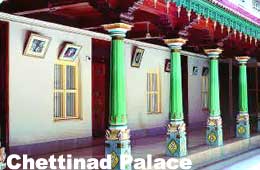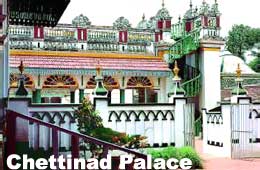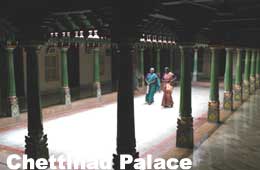>

The 110-year-old Chettinad Palace is an outstanding specimen of the Chettinad architecture. The oldest surviving building of this style, the Chettinad Palace was built by Dr Annamali Chettiyar, founder of the Indian Bank and the Annamalai University in Chidambaram. Dr Chettiyar was given the honorary title of "Raja" as he was the owner of 90 villages, which comprised the area called Chettinadu. Chettinadu extended 25 km from the north to south and 15 km from west to east.
The Chettinad Palace was designed by Dr Chettiyar and given the form by the local masons. The basic style of architecture reflects traditional architectural style of Chettinad. The construction material, decorative items and furnishings were mostly imported from East Asian countries and Europe. The marble was brought from Italy, chandeliers and teak from Burma, crockery from Indonesia, crystals from Europe and wall-to-wall mirrors from Belgium. The woodwork and stonework was inspired that of the houses in France and other European destinations.
The verandah is just next to the iron-gate and was converted into the waiting area for the visitors. The flooring of the waiting area is done with white marble.
 The meeting hall is decorated with several pairs of tusks; one of them is over 8 ft long and shipped from South Africa. There are also the portraits of family members and a collection of colored crystal. The ceiling has artistic patterns in vegetable dye over roofing plates made of copper soldered with a special variety of aluminum. The walls are made 1.5 ft to 3 ft wide to keep the interiors cool without the use of any electronic equipment like the air conditioners. The no cementing agent was used in the construction and the bricks are bound together with a paste of egg white, the extract of an unripe medicinal fruit found in the hills of Kadukkai and lime grind.
The meeting hall is decorated with several pairs of tusks; one of them is over 8 ft long and shipped from South Africa. There are also the portraits of family members and a collection of colored crystal. The ceiling has artistic patterns in vegetable dye over roofing plates made of copper soldered with a special variety of aluminum. The walls are made 1.5 ft to 3 ft wide to keep the interiors cool without the use of any electronic equipment like the air conditioners. The no cementing agent was used in the construction and the bricks are bound together with a paste of egg white, the extract of an unripe medicinal fruit found in the hills of Kadukkai and lime grind.
The hall leads to the central courtyard, which was used for weddings and religious ceremonies. The pillars around the courtyard are made of Burma teak. There is a colorful combination of blood-red tiles and sloping woodwork.
The ladies' hall has another courtyard and a rectangular dining hall. At least 250 people can sit and dine in the dining hall in the traditional style, i.e., by squatting on the floor. Two large mirrors are fitted to the walls. They are meant for the serving people to find out who needs more helpings, without actually walking up the length of the hall to the guest.
The third courtyard has several small rooms around it. They were meant to store crockery, food and other kitchen items. There are two kitchens in the third courtyard. The servants' quarters are situated at the far end at a proper distance from the residential area of the family. But they were close to the kitchen where the ladies of the house required their services. A couple of large stone hand-grinders are fixed on the veranda surrounding the courtyard. The food is still prepared in the traditional style with freshly ground spices. Eleven firewood ovens are lined along the kitchen wall and there are also two teak wood cupboards. It is said that all the Chettinad people have cupboards for provision, regardless of their financial status. 
A puja room in a corner of the courtyard is the place where Rani Seethai Achi, wife of Dr Annamalai Chettiyar, spent most of her time. Rows of aruamanai or the iron blades are hung on shelves outside the kitchen, meant for cutting vegetables and grating coconut.
There is also a small dining room for private dinners with an extendable rosewood table. The room has photographs and paintings of the British days. This dining area has its own kitchen and a storeroom.
The first floor comprises mainly of bedrooms and living rooms that are not open to outsiders.
|